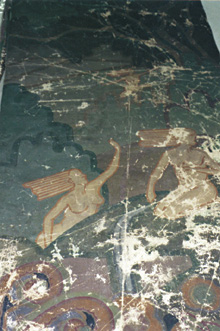York murals restored to former glory

Three historic murals rescued from the gutted shell of the former York Cinema have been restored and integrated into an auditorium in the new Engineering, Computer Science and Visual Arts Complex, where the York once stood.
The murals were commissioned by Emmanuel Briffa, who decorated more than 130 cinemas in Canada. They were created by artist Kenneth Hensley Holmden (1893-1963) to complement the York’s Art Deco style.
The murals adorned the walls of the cinema on Ste. Catherine St. between Guy and Mackay Sts. from the opening in 1938 until it was badly damaged by fire in 1989. When the university acquired the property in 1998, the murals were removed. They were restored by Laszlo Cser of Restorart. (See below)
The Art Deco period began around 1900 and ended around 1930. This distinctive style includes elements of the Orient, Egypt, and Greek and Roman antiquity. A big hit at the Paris Exposition of 1925, it spread quickly, and in North America, it survived the Depression and continued until the Second World War.
Holmden, the artist who created the murals, was born in Ottawa of British parents. After studying art in Ottawa and Toronto, he came to Montreal, where he is credited for works in the original Ruby Foos, on Decarie Blvd., and the Imperial Bank of Canada building on St. Jacques and McGill Sts. One of his works is in the permanent collection of the National Gallery of Canada.
Holmden lost a leg in the First World War, and spent many years in hospital. Amazingly, he stood on a scaffold on one leg to paint these vibrant and colourful murals.
The restoration and integration of the York murals into the new building are part of Concordia’s commitment to the promotion of public art. A giant, leafy work by Nicolas Baier, one of the biggest public commissions ever by the Quebec government, adorns the building’s exterior.
The unveiling on Monday was attended by Francine Senécal, the city councillor responsible for culture and heritage.
Monday being World Heritage Day, a conference was held in the university’s DeSève Cinema under the title Historic Interiors: A Heritage Worthy of Recog-nition and Protection.
Art deco murals from York Cinema underwent transformation

One of the murals before restoration (above) and after (below).

The unveiling of the York Cinema murals in the new Integrated Engineering, Computer Science and Visual Arts Complex on Monday afternoon represents a successful act of art restoration.
When the York Cinema was built in 1938, Emmanuel Briffa, one of the most sought-after theatre decorators in Canada, was hired by the architects Perry, Luke and Little. His elegant interior featured art deco motifs and materials that included terrazzo, marble, stainless steel, plastic veneer, vitrolite and plate glass.
Unfortunately, the theatre complex was left to deteriorate for decades before Concordia acquired the property in 1998.
Although the decision was taken to demolish the building, the city and the university agreed that what could be saved, would be.
As Director of Special Projects Clarence Epstein explained, “There were elements of the York decorative scheme that justified restoration, and we wanted to make sure these were incorporated into the new complex.”
Unfortunately, the interior of the theatre had decayed well past the point of repair, and only three of the eight original murals, as well as three stylized theatre masks on metal and a set of chevron decorative panels, could be recovered before the demolition.
The murals, painted by Kenneth Hensley Holmden, featured stylized nymphs that were considered somewhat daring at the time.
His paintings were met with considerable acclaim. La Presse described them in an article from November 1938 as “sections where a fortuitous diversity of lines and colour manifest themselves” (our translation).
Laszlo Cser, of the Toronto firm Restorart, was responsible for the complicated conservation process. A distinguished restorer who has worked on the Parliamentary Library in Ottawa, he described the challenges he faced.
“The degree of damage that the murals sustained during and following their removal from the original site location was extensive,” he said. This damage included mold, water damage and cigarette burns.
The most noticeable difference in the restored murals is the renewal of the original colour scheme. “The colour palette was determined by the original oils,” Cser explained. “Removal of the dirt and grime accumulations and the discoloured varnish layers revealed the original palette.”
After the time-consuming conservation was completed — each mural took between 120 and 500 hours to repair — the next question was how the panels would be incorporated into the new auditorium.
With a considerably smaller theatre space to work with and only three of the eight murals, their configuration could not be in its original sequence. However, Epstein, KPMB Architects and Laszlo Cser found a creative solution.
Epstein described how they were integrated.
“The larger works feature nymphs facing in different directions, and so it was decided to have these works face the front area of the auditorium, giving the impression that the nymphs are immersed in the lecturer, or what is on the screen.”
The third mural faces the front. It has been placed into the entrance of the theatre, so that people can interact with the piece.
As for the continued appreciation of the murals, Laszlo Cser concluded, “It will be left to the judgment of others to determine if the result was successful.”